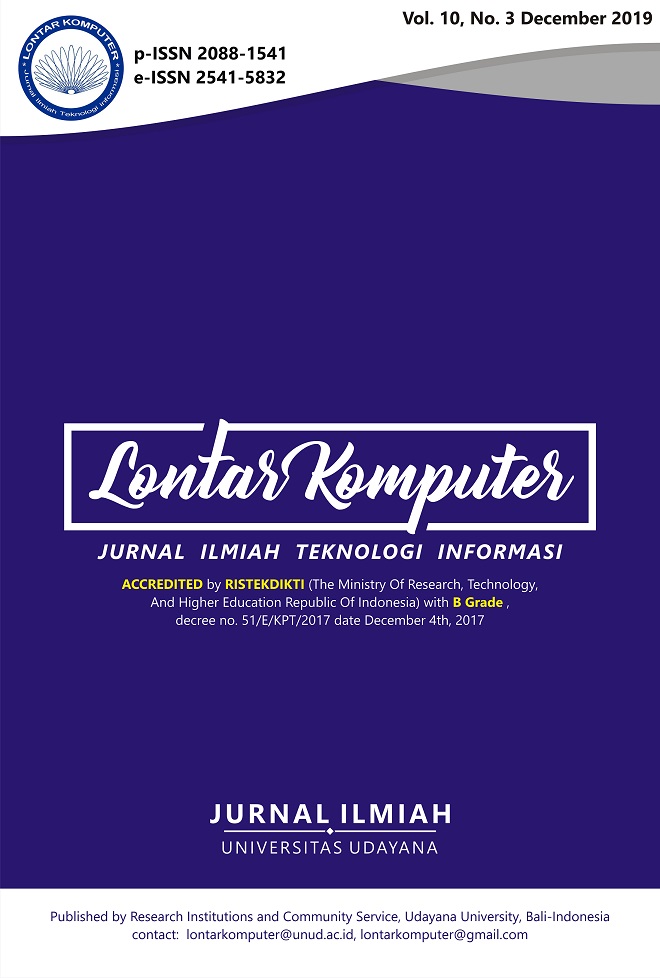Buildings Cracks Classification Using Zoning and Invariant Moment Features and Quadratic Discriminant Analysis Classifier
Abstract
Natural disasters such as earthquake often cause cracks in buildings and even demolish them. The cracked building must be assessed by an expert to determine whether the building is still suitable for use or not. The feasibility of a building is assessed based on the width, depth, and length of cracks in walls, beams, columns, and even the floor of the building. Only experienced experts can do such kind of task so that building assessment requires many structural engineering experts when an earthquake has happened. However, structural engineering experts are limited which able to do buildings assessment in the area affected. Therefore, the research based on a pattern recognition approach is conducted to classify cracks in buildings to be mild, moderate, or severe. It will be part of automatic building assessment based on the crack analysis. An alternative pattern recognition approach for classifying buildings cracks is a scheme based on zoning and shape features and Quadratic discriminant analysis (QDA) classifier. Based on the experimental results the proposed scheme gives reasonable achievement more than 80% of accuracy.
Downloads
References
[2] S. N. Sheerin, S. Kavitha, and G. Raghuraman, “Review and analysis of crack detection and classification techniques based on crack types,” International Journal of Applied Engineering Research, vol. 13, no. 8, pp. 6056–6062, 2018.
[3] A. Mohan and S. Poobal, “Crack detection using image processing: A critical review and analysis,” Alexandria Engineering Journal, vol. 57, no. 2, pp. 787–798, 2018.
[4] E. Hussain, A. Hannan, and K. Kashyap, “A zoning based feature extraction method for recognition of handwritten assamese characters,” International Journal of Computer Science and Technology, vol. 6, 01 2015.
[5] F. Camastra, “Handwritten greek character recognition with learning vector quantization,” in International Conference on Knowledge-Based and Intelligent Information and Engineering Systems. Springer, 2007, pp. 267–274.
[6] G. A. Abandah, K. S. Younis, and M. Z. Khedher, “Handwritten arabic character recognition using multiple classifiers based on letter form,” in Proceedings of the Fifth IASTED International Conference on Signal Processing, Pattern Recognition and Applications, ser. SPPRA ’08. Anaheim, CA, USA: ACTA Press, 2008, pp. 128–133. [Online]. Available: http://dl.acm.org/citation.cfm?id=1722683.1722710
[7] P. Prasanna, K. J. Dana, N. Gucunski, B. B. Basily, H. M. La, R. S. Lim, and H. Parvardeh, “Automated crack detection on concrete bridges,” IEEE Transactions on Automation Science and Engineering, vol. 13, no. 2, pp. 591–599, April 2016.
[8] Y. Shi, L. Cui, Z. Qi, F. Meng, and Z. Chen, “Automatic road crack detection using random structured forests,” IEEE Transactions on Intelligent Transportation Systems, vol. 17, no. 12, pp. 3434–3445, Dec 2016.
[9] A. R. Rizvi, P. R. Khan, and S. Ahmad, “Crack detection in railway track using image processing,” International Journal of Advance Research, Ideas and Innovations in Technology, vol. 3, no. 4, pp. 489–496, 2017.
[10] S. Kabir, “Imaging-based detection of aar induced map-crack damage in concrete structure,” NDT & E International, vol. 43, no. 6, pp. 461–469, 2010.
[11] S. Kabir, P. Rivard, G. Ballivy, and D.-C. He, “Textural analysis for crack-detection using infrared thermography, visual colour, and greyscale concrete imagery,” in Joint International Conference on Computing and Decision Making in Civil and Building Engineering, 06 2006, pp. 14–16.
[12] L. Zhang, F. Yang, Y. D. Zhang, and Y. J. Zhu, “Road crack detection using deep convolutional neural network,” in 2016 IEEE international conference on image processing (ICIP). IEEE, 2016, pp. 3708–3712.
[13] R. C. Gonzalez and R. E. Woods, Digital Image Processing (3Rd Edition). Prentice Hall, August, 2007.
[14] T. Zuraiyah, A. Qur’ania, and C. R Pitoyo, “Optimization of feature extraction using combined image centroid zone and zone centroid zone method,” in IORA International Conference on Operation Research, 09 2016.
[15] R. O. Duda, P. E. Hart, and D. G. Stork, Pattern Classification (2Nd Edition). New York, NY, USA: Wiley-Interscience, 2001.
[16] A. Tharwat, “Linear vs. quadratic discriminant analysis classifier: a tutorial,” International Journal of Applied Pattern Recognition, vol. 3, no. 2, pp. 145–180, 2016.
[17] X. Sicotte, “Linear and quadratic discriminant analysis,” 2018. [Online]. Available: https://xavierbourretsicotte.github.io/LDA_QDA.html
[18] Ça˘ glar Fırat Özgenel, “Concrete Crack Images for Classification,” 2018. [Online]. Available:
http://dx.doi.org/10.17632/5y9wdsg2zt.1
The Authors submitting a manuscript do so on the understanding that if accepted for publication, the copyright of the article shall be assigned to Jurnal Lontar Komputer as the publisher of the journal. Copyright encompasses exclusive rights to reproduce and deliver the article in all forms and media, as well as translations. The reproduction of any part of this journal (printed or online) will be allowed only with written permission from Jurnal Lontar Komputer. The Editorial Board of Jurnal Lontar Komputer makes every effort to ensure that no wrong or misleading data, opinions, or statements be published in the journal.
 This work is licensed under a Creative Commons Attribution 4.0 International License.
This work is licensed under a Creative Commons Attribution 4.0 International License.























